
KeywordSearch: Steal Clicks That Viewers Already Search For
You’ll write titles that feel familiar because they match what people type. KeywordSearch surfaces those exact phrases so your video meets them halfway. You’ll keep the promise in the first 60 seconds to boost watch time. Your thumbnail and title finally work together like best friends.
Friend to friend: a few links are affiliate links. When you purchase, I might get a tiny thank-you from the company, with zero added cost to you. I only recommend things that I’ve actually tried and looked into. Nothing here is financial advice; it is for entertainment. Read the full affiliate disclosure and privacy policy.
Skip guesswork. In 15 minutes, you’ll turn one seed idea into three topics you can film this week, using KeywordSearch and your own Studio data.
Check CTR, Key Moments, and YouTube search terms so your title and opening minute land. Zero devs, $0 extra tools.
This playbook is simple: start in KeywordSearch to generate relevant ideas fast, then let YouTube Studio confirm which one deserves your time.
CTR shows whether your title–thumbnail pair attracts clicks from counted impressions; Key Moments shows if your opening holds attention; YouTube search terms reveal the exact words viewers used to find you.
With those three checks, you can green-light a topic or refine the phrasing before you ever hit record. You move from “hope” to a repeatable loop you can run weekly in under 20 minutes.
Quick promise: by the end, you’ll know how to turn one seed idea into a validated video plan in about 15 minutes, plus how to refresh older uploads with better phrasing your audience already searches for. Results vary by channel and execution; no rankings are guaranteed.

The 15-Minute KeywordSearch Workflow (from idea to shortlist)
One seed in, three shoot-ready topics out. Use Keyword Research for fast signal, then Auto Expansion to widen without noise. Keep only ideas you can film this week.
Seed Right: 3 inputs that change results
Open KeywordSearch → Keyword Research and type 1–3 seed phrases you could realistically cover next. Think in plain viewer language, not jargon.
Example: “budget camera setup,” “YouTube intro ideas,” “plumber drain clog.” The tool analyzes search volume, competition, and relevance so you see what’s worth exploring first.
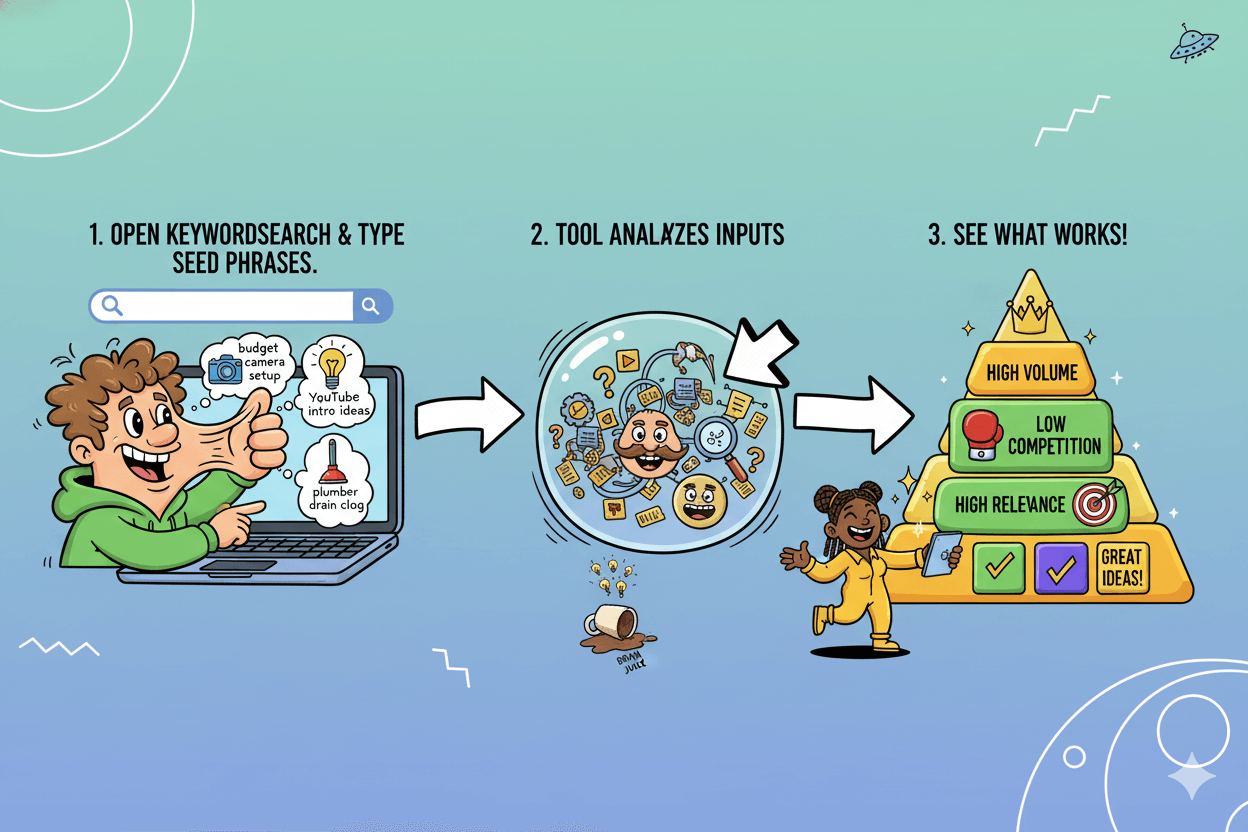
Auto-Expansion: widen without losing relevance
Click AI Topic Auto Expansion to uncover related queries you may not think of on your own. This feature “dives deep” into your topic and generates a larger universe of closely related phrases.
Scroll for phrasing patterns and repeat words that keep showing up; they often mirror how viewers actually search. Save the most on-brand options to your shortlist.
pro_tip: If you see a cluster repeating a promise like “without editing” or “under $100,” note it. Those modifiers often become high-pull title phrases later. For broader grounding on intent-match, skim a current YouTube SEO guide after shortlisting.

Shortlist Rules: choose 3–5 ideas you can film this week
From your expanded set, apply simple rules so you don’t stall.
- Relevance first: favor phrases your actual audience would type.
- Make-able now: pick topics you can script and shoot in the next 7 days.
- Signal mix: balance a couple broader terms with at least one specific, qualifier-rich phrase.
Vendor pages confirm KeywordSearch ranks by volume, competition, and relevance, which helps you make these quick calls. External guides back the strategy of aligning to searcher intent rather than chasing volume alone.
Save three to five ideas, then move to analytics validation in Studio before you hit record. – Backlinko
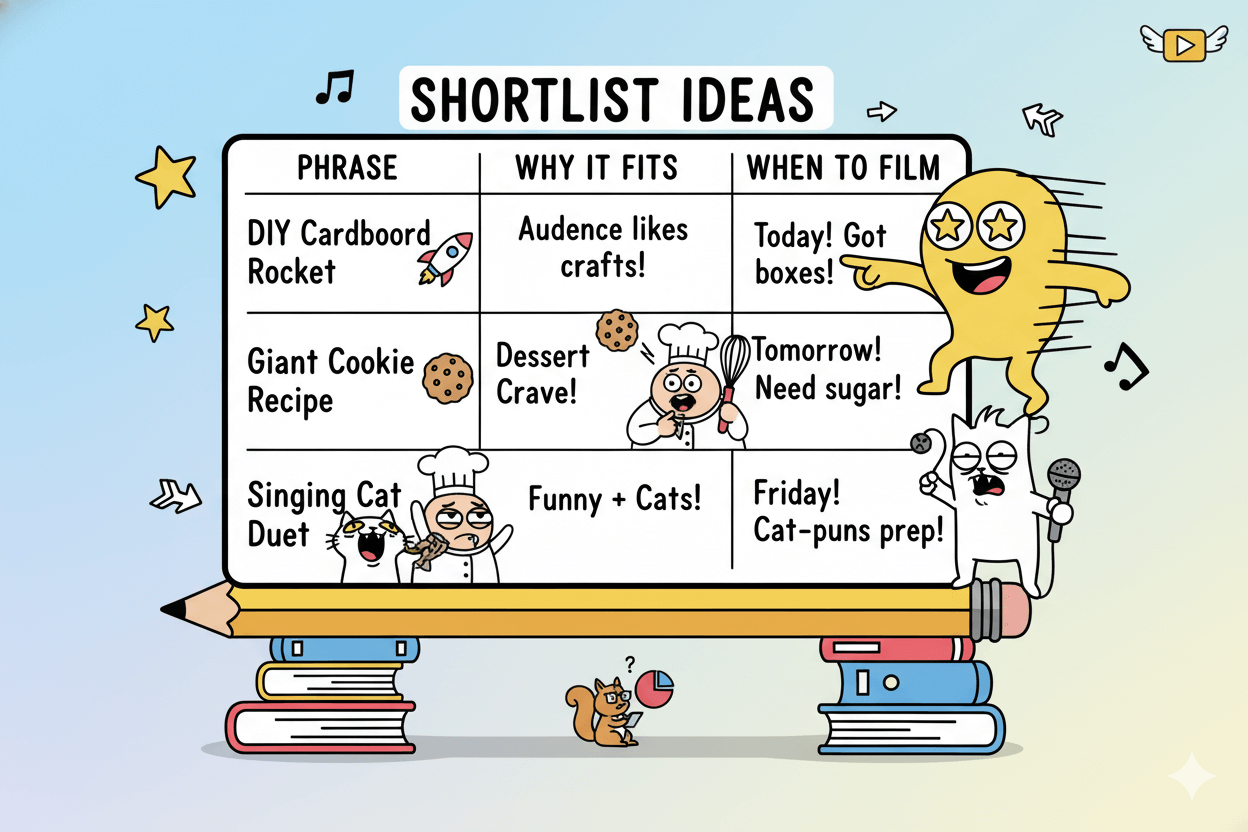
Reverse-Engineer Competitors With YouTube Ad Spy
Ads reveal language that already pulls. Mine repeat phrases and reframe them into honest tutorials in your voice.
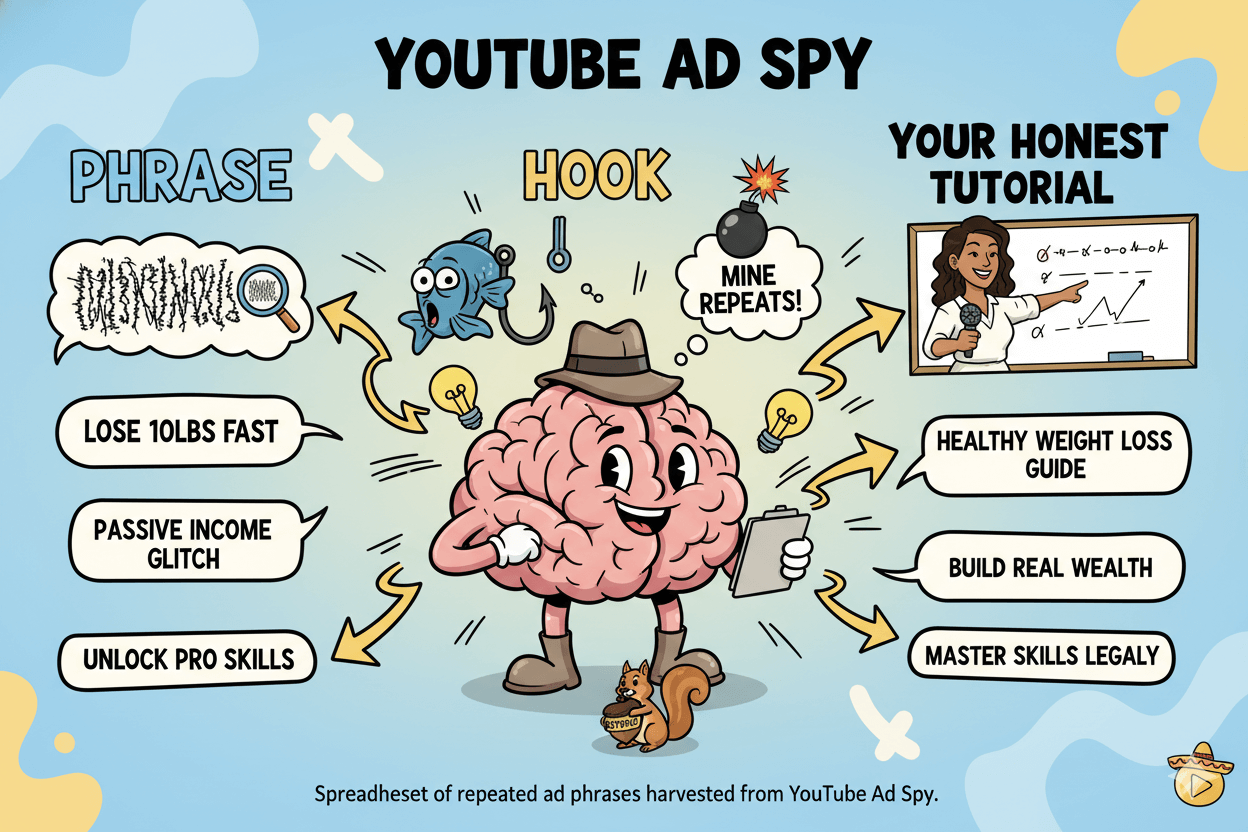
Spot Repeat Phrases Across Top Ads
In YouTube Ad Spy, type a broad niche term or competitor brand. Scroll results and note phrases that repeat across multiple high-view or rising-spend creatives, such as “without editing,” “under $100,” or “in 10 minutes.”
Consistency signals market language and demand. Sort by views or spend-trend to prioritize which hooks likely reached more people or grew recently, then collect 5–10 recurring phrases before you narrow.
Angle Shift: From Ad Promise to Organic Topic
Turn paid hooks into organic titles by reframing the outcome as a tutorial or case study. Example: an ad hook like “Grow with faceless videos” becomes “Faceless YouTube: 3 Scripts That Earn Watch Time.”
Preserve the audience’s exact wording where possible, but add your specifics: niche, constraints, or step count. If your list includes multiple modifiers (price, time, tool), draft two title variants and keep the stronger one for the upload.
This approach leverages validated phrasing without copying creative verbatim.
Build a Swipe File You Can Film
Create a simple table with columns for Phrase, Why it resonates, Your proof, and When to film. For each candidate, write the opening 30–60 seconds that will fulfill the title’s promise on screen.
Highlight which phrases map cleanly to your next recording day. Keep your shortlist to three to five topics so production doesn’t stall.
As you publish, track which rephrased angles keep appearing in your YouTube search terms and iterate titles accordingly in your next batch.
Validate Ideas With YouTube Analytics Before You Double Down
Let the dashboard decide. CTR shows the pull, Key Moments show the hold, and search terms show the wording. Ship what clears your baseline.
CTR: Find It and Read It
Go to the video’s Reach tab and review Impressions CTR. CTR measures how often viewers watched after seeing a counted impression on YouTube.
Not every exposure counts as an impression, so CTR represents a subset of total views. Use CTR trend against your normal range, not a universal “good” number.
If CTR is weak while impressions grow, tighten the promise in the title and test a thumbnail that matches it word-for-word.
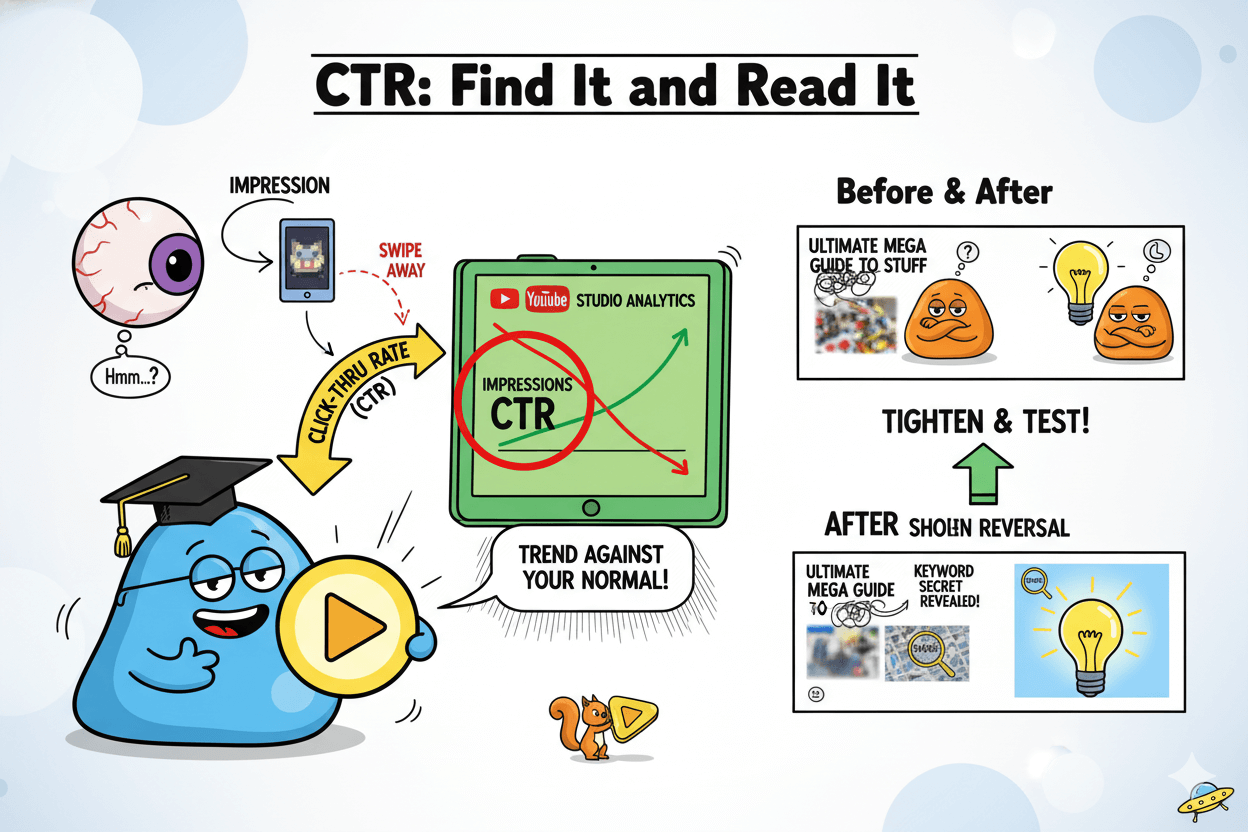
Key Moments: Fix the First 30 Seconds
Open Engagement → Key moments for audience retention for the same video. The graph shows where viewers skip, drop, or rewatch.
Expect data to take a little time to process. If you see an early dip, rewrite the first 30–60 seconds to fulfill the title sooner, reduce throat-clearing, and preview the payoff in one sentence.
Mark the timestamp where interest stabilizes and match your hook to that point next time.
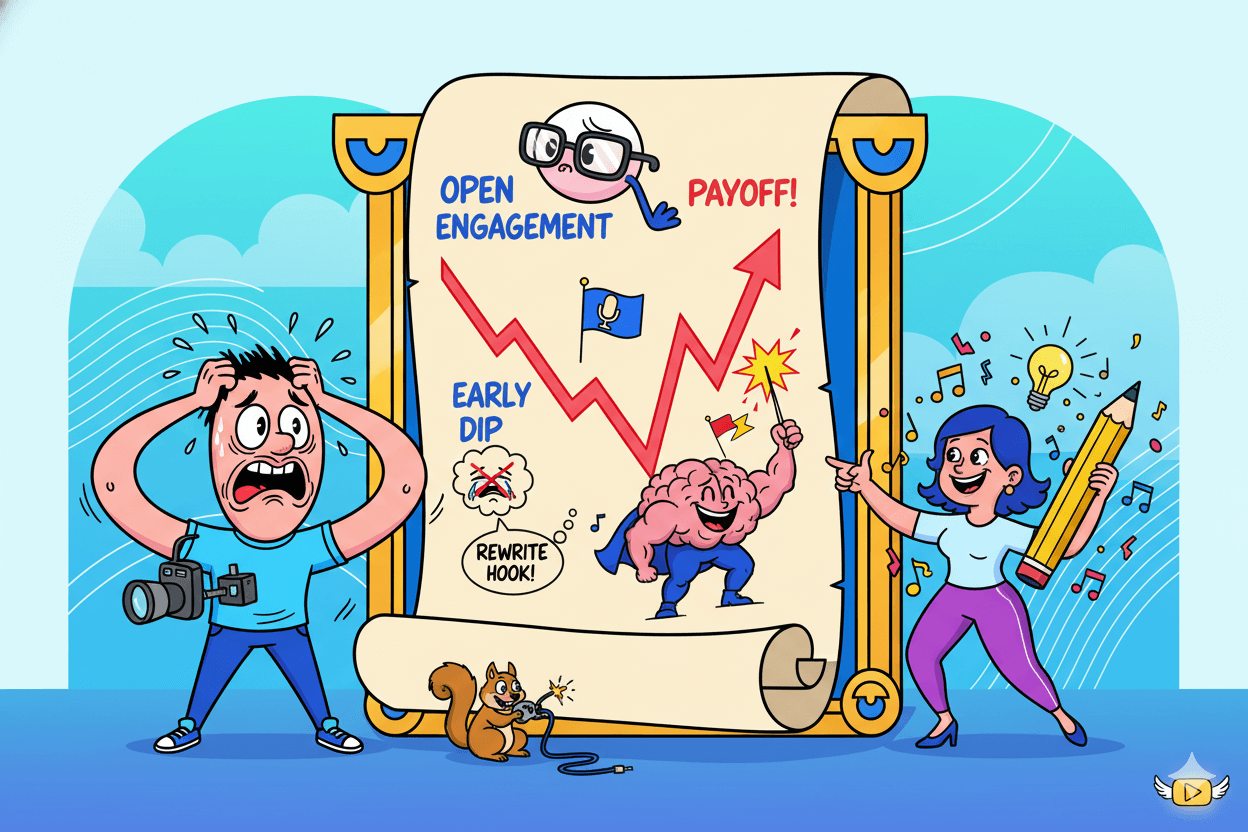
Reach → YouTube Search Terms: Steal Your Own Phrasing
Under Reach, open YouTube search terms to see the exact queries viewers used to find the video. Copy the phrasing that appears most and mirror it in your title or the first lines of your description.
If the terms you want are missing, your wording may not match how people search. Adjust the title or description to match the strongest relevant term, then recheck over the next 2–4 weeks.
do’s_and_don’ts
Do compare CTR and retention to your own baseline. Do mirror the exact words in YouTube search terms.
Don’t chase a global “good CTR” number; use context and trends.
For framing on core metrics and why they matter, see YouTube’s Creator Blog overview.
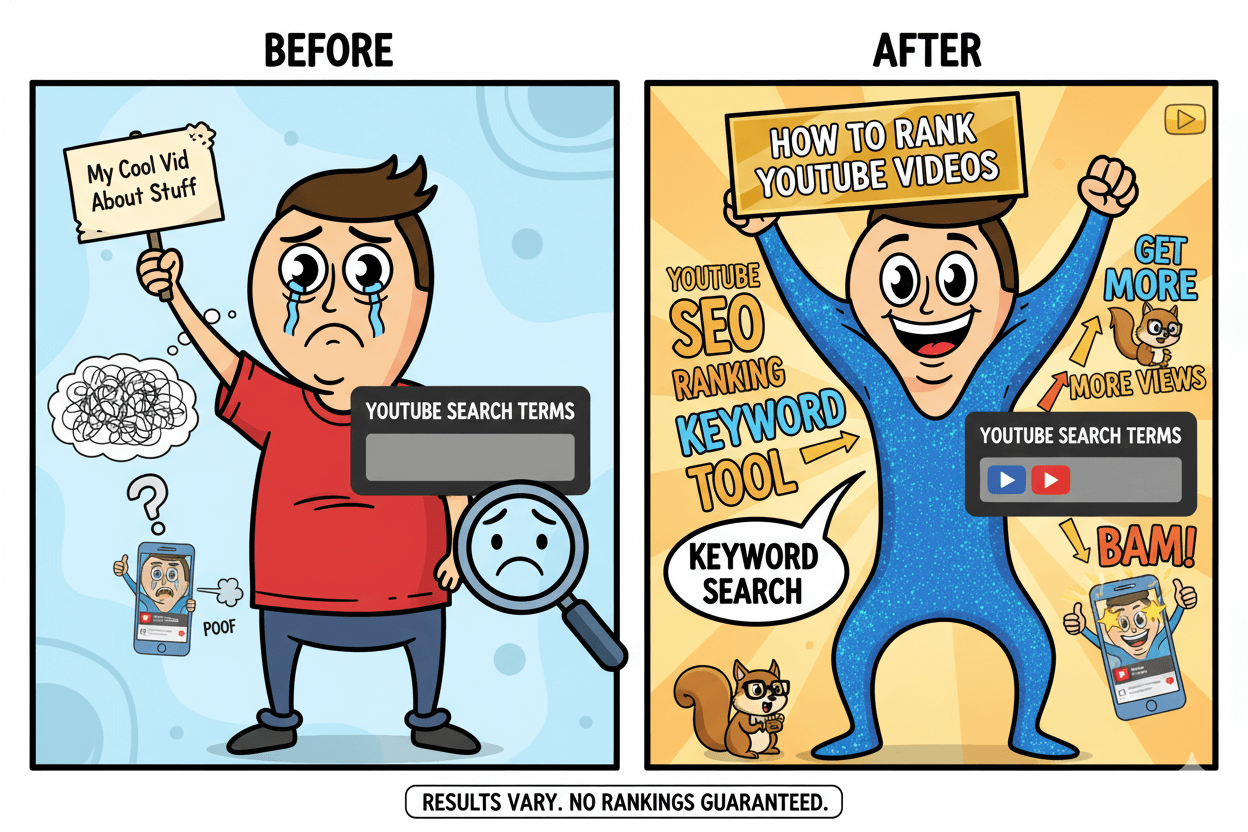
Write Titles, Descriptions, and Chapters That Reflect Real Queries
Use the words your viewers already typed. Mirror one strong phrase in your title and deliver it on screen in the first minute.
Title Patterns from Top Results
Write for people first, using the exact phrase your audience uses in YouTube search terms, placed early in the title.
Clear, specific titles paired with matching thumbnails lift CTR; large guides emphasize intent match over keyword stuffing.
Numbers and concrete modifiers often help communicate scope without clickbait. Use one primary phrase once, then add a simple outcome or qualifier.
quick_win: Draft two variants: “Primary phrase + outcome” and “Primary phrase + number.” Publish the one that best matches the video’s first minute and revisit CTR after initial impressions.
Description Lines That Sell the Click Honestly
Descriptions help searchers and YouTube understand your content. YouTube’s own guidance recommends writing descriptions with keywords to aid discovery; keep them natural and summary-led, not stuffed.
Aim to use your primary phrase naturally once or twice, add a 1–2 sentence promise of value, then a short bullet list of what viewers will learn. Independent guides echo this balance of clarity and natural keyword use.
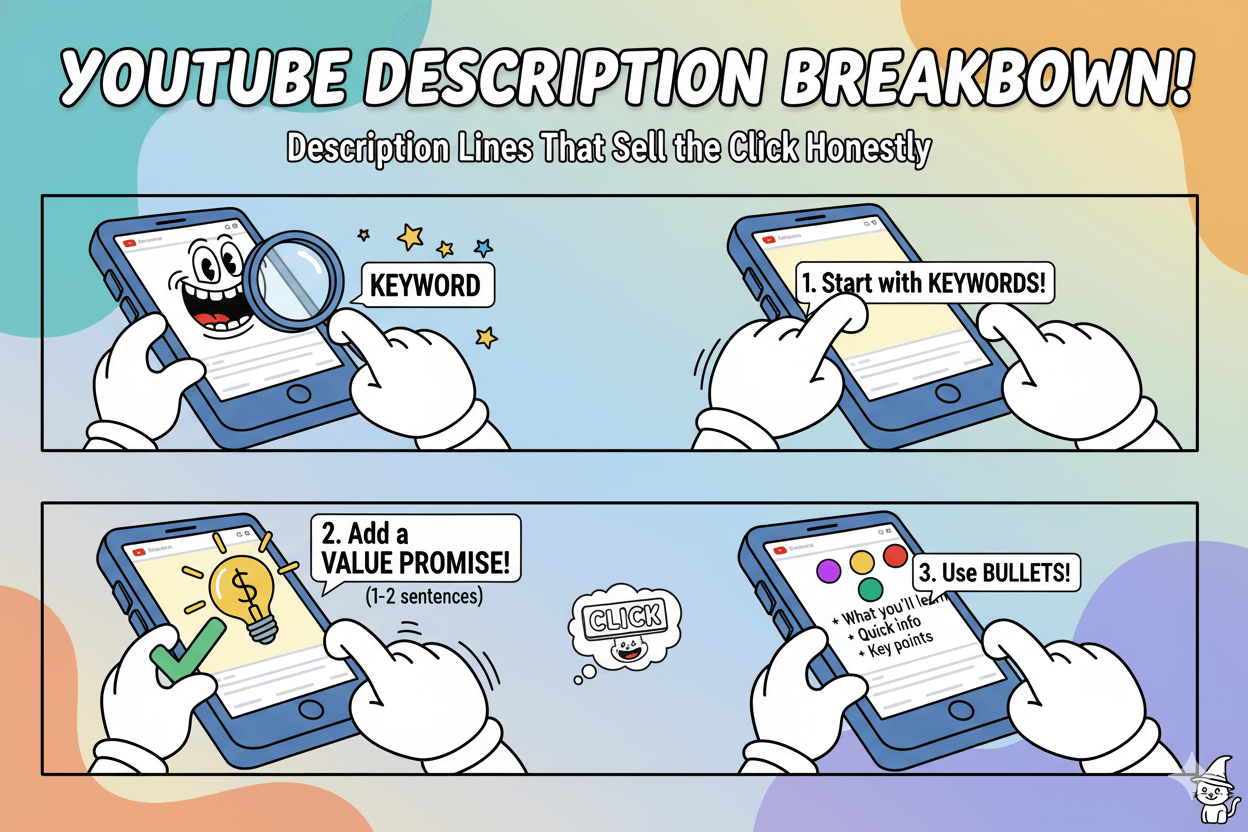
Chapters That Match “Key Moments”
Chapters improve navigation and can reinforce relevance when their labels mirror how viewers describe topics.
To add manual chapters, list timestamps and titles in the description; the first must start at 00:00, include at least three timestamps, and each chapter must be ≥10 seconds.
You can also allow automatic chapters in Studio if you prefer a faster setup. Keep chapter names short and descriptive so they match the promise that brought the viewer in.
pro_tip: Use the same simple phrasing across title, opening hook, first description line, and first chapter. This alignment helps your CTR and early retention work together, not at odds.
For extra context, skim a current YouTube SEO tutorial that demonstrates how titles, descriptions, and chapter names reinforce search intent.
Launch Scorecard: 14–28 Days to Confirm the Winner
Trends beat snapshots. Check CTR, early retention, and search terms weekly for 2–4 weeks. Decide: keep, iterate, or refresh.
Week-by-Week What to Check
- CTR trend: In Reach, CTR shows how often viewers clicked after a counted impression on YouTube. Use the trend against your channel’s typical range; not every exposure is a counted impression, so avoid universal “good” numbers.
- Early retention: In Engagement → Key moments, look for early dips or spikes. High retention signals viewers find the content engaging, which can positively affect reach. Data often takes 1–2 days to process, so expect slight delays.
- Search phrasing: In Reach → YouTube search terms, watch whether the list expands and whether top phrases match your title and description language. If the terms you expect aren’t present, your wording may not match how people search.
Thresholds: Compare to Your Baseline
Decisions ride on your history. If CTR is stable but retention dips at 0:20–0:40, your hook likely under-delivers; rewrite the first lines to deliver the promise sooner.
If retention holds but CTR decays as impressions expand, refine the title for clarity and alignment with the thumbnail. The Creator Blog’s framing: focus on core metrics and viewer experience, not fixed “good” targets.
pro_tip: Use Advanced mode to break down performance by surface (e.g., YouTube Search vs. Browse) when diagnosing CTR or retention swings.
Decide: Keep, Iterate, or Refresh
- Keep: CTR and retention are within or above baseline, and new YouTube search terms appear over the window. Keep publishing the next video and log phrasing that worked.
- Iterate: CTR under baseline with flat search terms. Ship one controlled change: clearer title or a thumbnail that restates the promise. Recheck a week later.
- Refresh: Search terms show interest but don’t match your wording, or Key moments reveal an early drop. Retitle using a top viewer phrase and trim the intro to fulfill it faster; monitor again for 14–28 days.
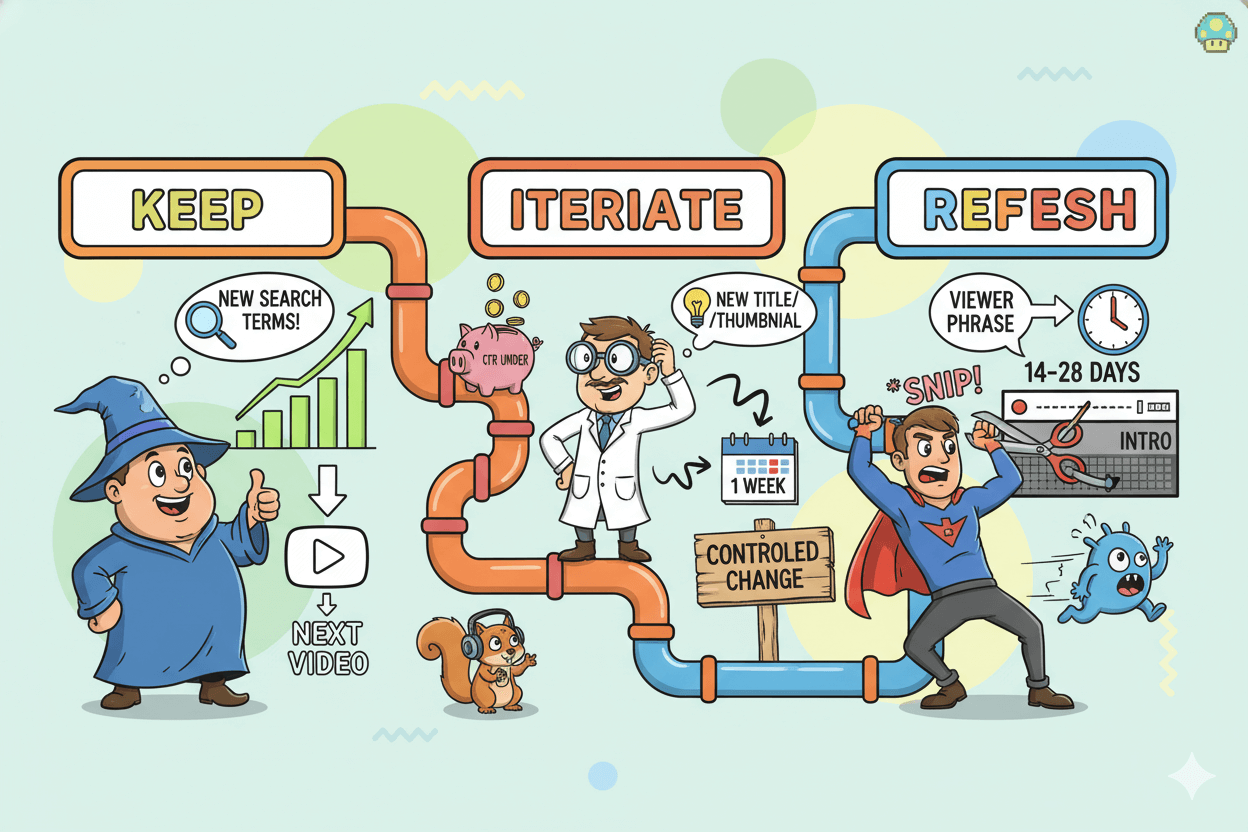
Required notice: Results vary by channel and execution. No rankings are guaranteed.
Refresh Old Videos With New, Validated Keywords
Start where you already win impressions. Retitle with that exact phrase and align the first minute; measure for 2–4 weeks.
Pick the Phrase You Already Win
Go to the video’s Reach tab and open YouTube search terms. Note the exact wording viewers use to find your video and star the term that best matches your content.
That phrasing is your north star for the refresh, because it reflects real demand from your audience—not guesses or tags. Prioritize terms that show impressions today so you can ride existing momentum.
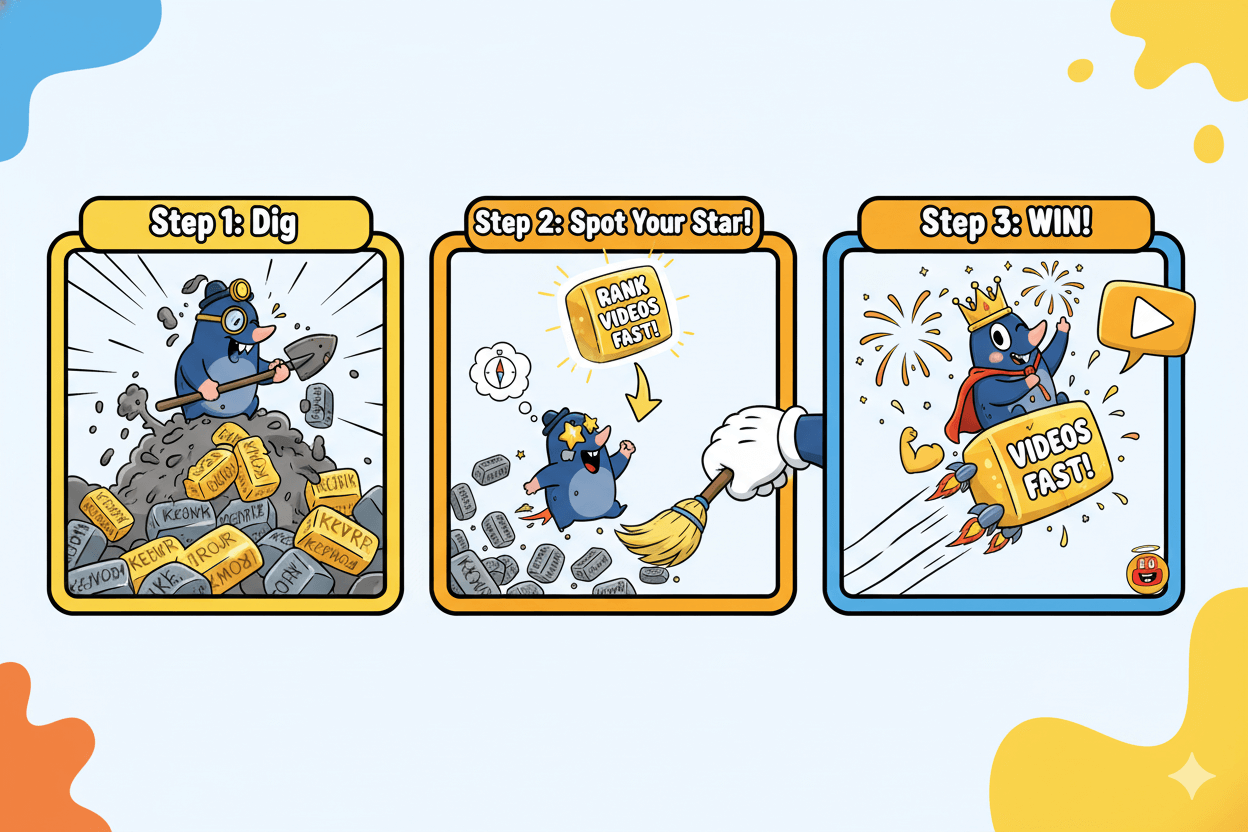
Retitle + First-Minute Alignment
Edit the video details in Studio and update the title to include that exact phrase once, early. Keep it clear, specific, and honest.
Then tighten your opening 30–60 seconds so the on-screen hook fulfills the title right away; a fast payoff supports stronger early retention and helps your refresh stick.
If you use chapters, rename the first one to echo the same phrase for clean alignment.
pro_tip: Pair the new title with a thumbnail that repeats or unmistakably visualizes the same promise. The Creator Blog frames CTR as a signal of relevance; title–thumbnail coherence improves that signal.
Measure the After
Give the update 14–28 days. Each week, check three surfaces together:
- CTR in Reach to see if the new wording lifts click pull for counted impressions on YouTube.
- Key moments for audience retention to confirm your tighter intro holds attention; processing can take a day or two, so read trends, not snapshots.
- YouTube search terms to verify that the refreshed wording begins to appear—or rises—in the queries that find your video.
If CTR rises and early dips flatten, keep the new title. If search terms still don’t match, adjust the description’s first line to mirror the target phrase more closely and recheck next week.
Use one change at a time so you can see cause and effect. Results vary by channel and execution; there are no guarantees, but this controlled loop lets your audience’s language lead the way.
Weekly Research Ritual: Keep a Pipeline of Proven Topics
Thirty minutes, once a week. Auto Expand 1–2 seeds, add new search terms, and lock next week’s shoot list.
Inputs: Seeds, Search Terms, Competitor Angles
Start with two quick inputs: today’s seed phrases and last week’s YouTube search terms.
Topic Auto Expansion “dives deep” into your seeds and reveals closely related queries you may not think of on your own; skim for repeating modifiers like “under $100,” “in 10 minutes,” or “without editing.”
These phrases often mirror how your audience actually searches. If you maintain a competitor swipe file from Ad Spy, scan it for recurring wording and add only what fits your channel’s voice.
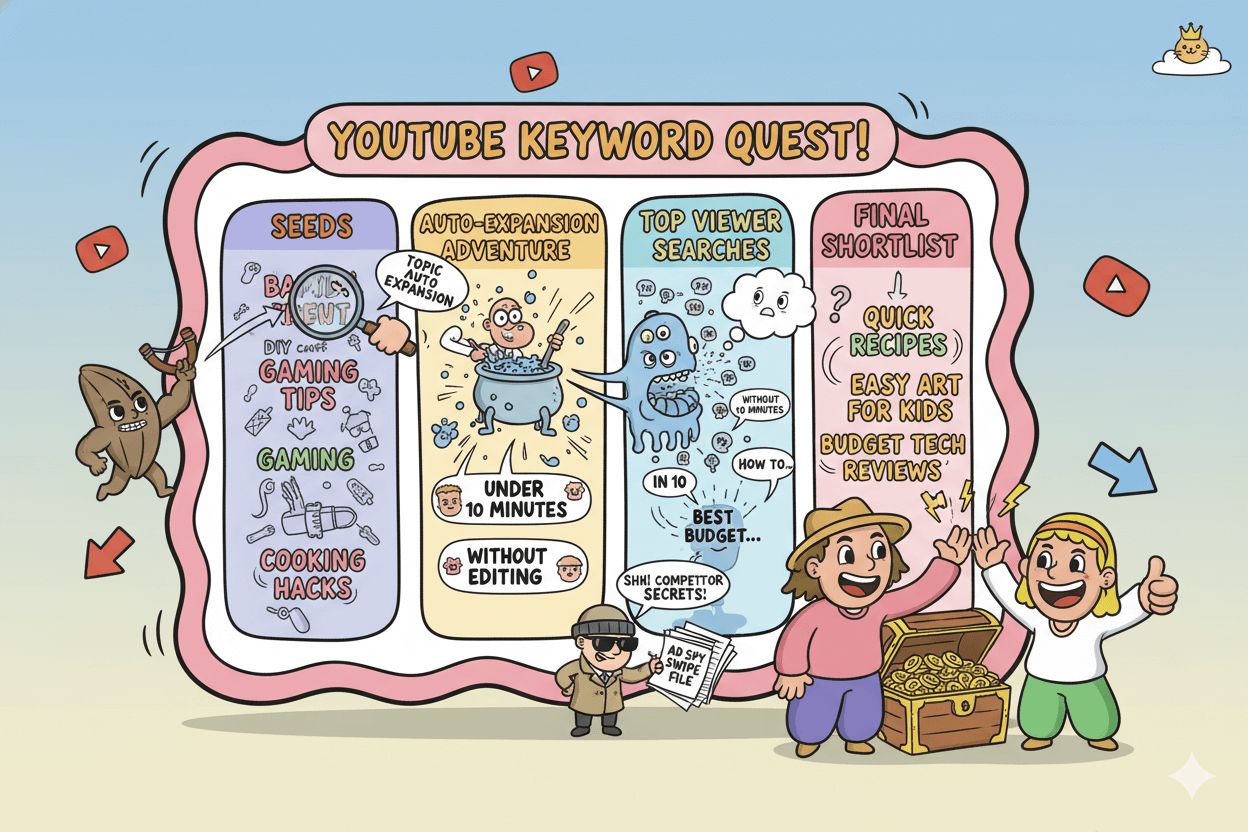
Processing: Expand, Sort, Shortlist
Run Topic Auto Expansion on each seed. Sort the expanded list by relevance to your niche and production reality, not just volume.
Star the terms that match phrasing you see in your YouTube search terms report, since those already pull real impressions for your channel.
Shortlist three ideas that you can film this week and park the rest in a backlog labeled by theme. This balancing act keeps momentum while aligning with proven viewer language.
pro_tip: If the same adjective or outcome keeps surfacing across expanded terms and your search-terms report, echo it once in your next title and deliver that promise in the first 30–60 seconds. Then monitor CTR and early retention to see if alignment improved.
Outputs: Titles, Hooks, Chapters
For the top idea, draft a working title that uses one primary phrase exactly once. Write a 1–2 sentence hook that fulfills the title immediately on screen, and outline chapters that mirror the same simple language.
Drop the remaining two shortlisted ideas into next week’s recording plan so you never face a blank page.
This is the same loop you’ll repeat: expand with Topic Auto Expansion, mirror phrasing found in YouTube search terms, and publish with a clear, fast payoff.
Over time, you’ll see the phrasing you chose appear more often in your Reach reports, confirming that your research and scripting are in sync.
Required notice: Results vary by channel and execution. No rankings are guaranteed.
FAQs: Answering KeywordSearch Questions You Have In Mind!
Answers in one line with exact paths. Verify in Studio in seconds.
CTR in Studio
Where is CTR and what does it mean?
Go to the video’s Analytics → Reach tab and look for Impressions click-through rate (CTR). It measures how often viewers watched after a counted impression on YouTube, so it represents a subset of total viewing contexts.
Compare CTR to your channel’s normal range, not a universal number. If CTR underperforms as impressions rise, tighten the title for clarity and match the thumbnail to the promise.
Quick path: Studio → Content → pick video → Analytics → Reach → “Impressions click-through rate.”
Key Moments basics
What are “Key moments for audience retention,” and why does it lag?
This report shows where viewers rewatch, skip, or drop off across the timeline, highlighting strong and weak sections of your video. Data typically needs 1–2 days to process, so read trends rather than hourly swings.
If you see an early dip, promise the outcome sooner, trim preamble, and mirror your title in the first 30–60 seconds.
Quick path: Studio → Content → pick video → Analytics → Engagement → “Key moments for audience retention.”
Search terms report
How do I see the exact words viewers used to find my video?
Open Analytics → Reach → YouTube search terms for the selected video. This card lists the precise queries that led to discovery inside YouTube.
Mirror one high-relevance phrase in your title and description, then monitor whether that wording appears more often over the next 2–4 weeks.
Quick path: Studio → Content → pick video → Analytics → Reach → “YouTube search terms.”
Bonus: Fast research and competitor phrasing
How do I find YouTube keywords quickly?
Use KeywordSearch → Keyword Research with 1–3 seeds, then run AI Topic Auto Expansion to widen your list while staying on-topic. Shortlist three to five ideas before validating in Studio.
How can I use competitor language ethically?
Open KeywordSearch → YouTube Ad Spy. Search your niche, sort by views or spend-trend, and capture recurring phrases. Adapt those angles into tutorials with your proof and voice—don’t copy ad creative verbatim.
Required notice: Results vary by channel and execution. No rankings are guaranteed.
Conclusion
Here’s your simple loop to keep: start in KeywordSearch with a few seed phrases, widen smartly with Topic Auto Expansion, and pull three to five ideas you can actually film this week.
Then, let YouTube Studio confirm the pick: check Impressions CTR in Reach to see if your title–thumbnail combo attracts clicks from counted impressions, scan Key moments for audience retention to make sure
…your opening delivers the promise, and mine YouTube search terms to mirror the exact phrasing viewers use.
If you need angles fast, peek at YouTube Ad Spy to spot recurring hooks and translate them into honest, tutorial-style titles in your voice.
Publish on a simple cadence and judge by trends, not one-day spikes. For the first 14–28 days, review CTR, early retention, and search-term growth weekly, then make one controlled change at a time.
Keep a small backlog from Topic Auto Expansion and schedule your next shoot before you open the editor.
When a phrase performs, reuse it in your next title and in the first 30–60 seconds on screen; when it misses, refresh the wording and tighten the hook. Small cycles stack into compounding gains.
Results vary by channel and execution; no rankings are guaranteed.

KeywordSearch: Rank Faster on YouTube Today!




